You'll discover seven essential DIY wooden cutter plans that'll elevate your soap-making craft. From the single-wire traditional design to a multi-wire adjustable frame, each plan offers unique benefits for precise cuts. You can build a modular trimming station, hand-operated guillotine, or custom mold-sized templates using quality materials like maple or birch. With proper tools and safety measures, these plans transform your workspace into a professional artisan studio. Let's explore each design's step-by-step construction process.
Essential Materials and Tools for Building Wooden Soap Cutters
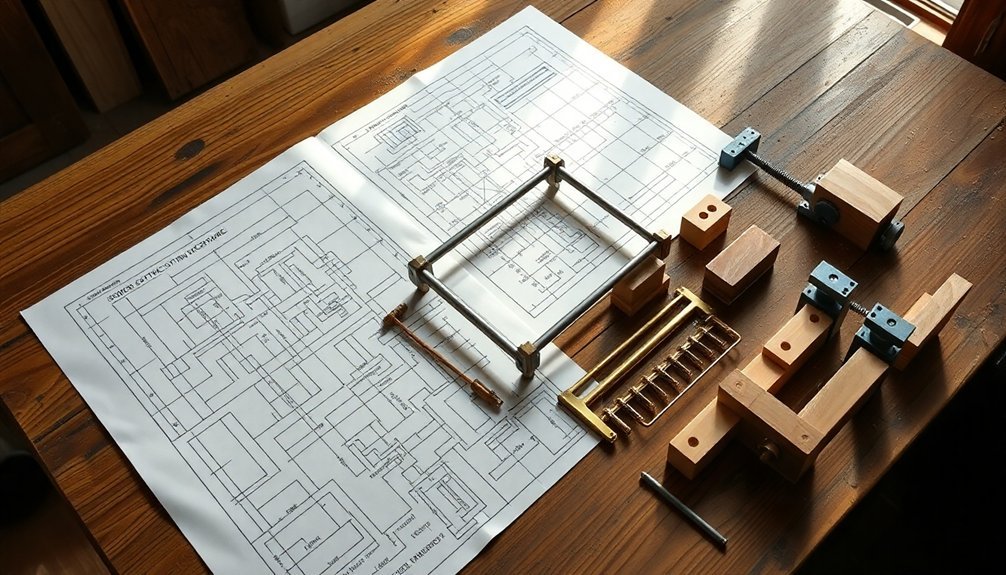
When starting on a wooden soap cutter project, you'll need specific materials and tools to secure professional results. Select high-quality wood like maple or birch for durability, and pair it with a sharp blade that'll guarantee clean, precise cuts every time.
Your essential tools for wood should include hand saws for accurate cutting, chisels for detailed work, and a drill for creating holes and fittings. Consider investing in a laser engraver if you want to add custom measurements or decorative elements to your cutter.
Hand saws, chisels, and drills form the backbone of soap cutter construction, while laser engraving adds precision and personalized touches.
When cutting wood, maintain steady control and follow your marked guidelines carefully.
Don't forget about maintenance – regular blade sharpening and wood inspection will keep your soap cutter performing at its best. Store your tools properly and check for wear to secure long-lasting functionality.
Single-Wire Traditional Soap Cutter Design
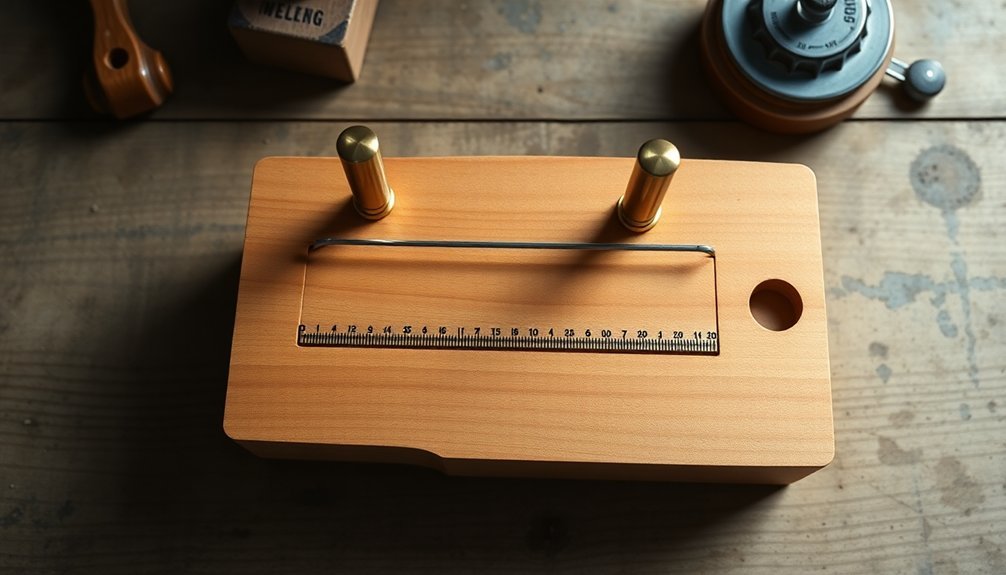
You'll need a sturdy wooden frame, stainless steel wire, and basic hardware like eye hooks and wing nuts to build your traditional single-wire soap cutter.
To assemble your cutter, start by constructing a rigid frame that maintains proper wire alignment.
Then install adjustable mounting points for the cutting wire.
When mounting the wire, you'll want to incorporate a reliable tensioning mechanism, such as threaded eye hooks, to maintain consistent wire tautness for clean, precise cuts.
Materials and Assembly Requirements
Crafting a reliable single-wire soap cutter starts with selecting the right materials and understanding proper assembly techniques. You'll need durable hardwood for your wooden frame, ensuring it withstands the cutting process. Choose either fishing line or stainless steel wire for your cutting element, along with appropriate hardware for stability.
| Component | Purpose | Requirements |
|---|---|---|
| Frame | Support structure | Hardwood, sturdy joints |
| Wire | Cutting element | High tension strength |
| Hardware | Assembly/adjustment | Screws, hinges, guides |
During assembly, focus on securing the wire with even tension across the frame. Don't forget to incorporate an adjustable mechanism for different soap sizes. Always prioritize safety precautions by wearing protective gloves and maintaining a clear workspace. Your frame's design should allow for easy wire replacement while maintaining structural integrity throughout repeated use.
Essential Build Steps
Building a single-wire soap cutter involves five foundational steps that guarantee precise, consistent cuts.
First, use your wood cutting machine or hand tools to create a sturdy frame from 1.5-inch thick wood pieces, ensuring they're square and level.
Next, install the specialized cutting wire, making sure it's properly tensioned to prevent sagging during use.
Add an adjustable fence to your cutting tool by mounting guide rails that'll help maintain uniform bar widths.
While power tools can speed up construction, sharp blades and proper safety tips are essential – always wear protective eyewear during assembly and operation.
Finally, test the wire's tension and cutting performance with a sample soap block. If needed, make minor adjustments to achieve those perfect precise cuts you're looking for in your artisanal soap-making process.
Tension Control Tips
Since consistent tension plays a vital role in achieving clean soap cuts, mastering proper wire adjustment becomes essential for any artisan's success. To maintain ideal cutting performance, you'll need to focus on precision and regular tension control checks.
| Tension Level | Best For | Maintenance Tips |
|---|---|---|
| Light | Soft Soaps | Weekly Checks |
| Medium | Standard Bars | Bi-weekly Checks |
| Firm | Hard Soaps | Monthly Checks |
| Extra Firm | Specialty Bars | Daily Checks |
When selecting adjustable tensioning mechanisms for your cutting tools, consider using turnbuckles or springs that you can easily modify. You'll want to inspect your wire materials regularly for signs of wear and replace them promptly to maintain artisan crafting quality. Try experimenting with different wire types like stainless steel or nylon to find what works best with your specific soap varieties.
Multi-Wire Adjustable Soap Cutting Frame
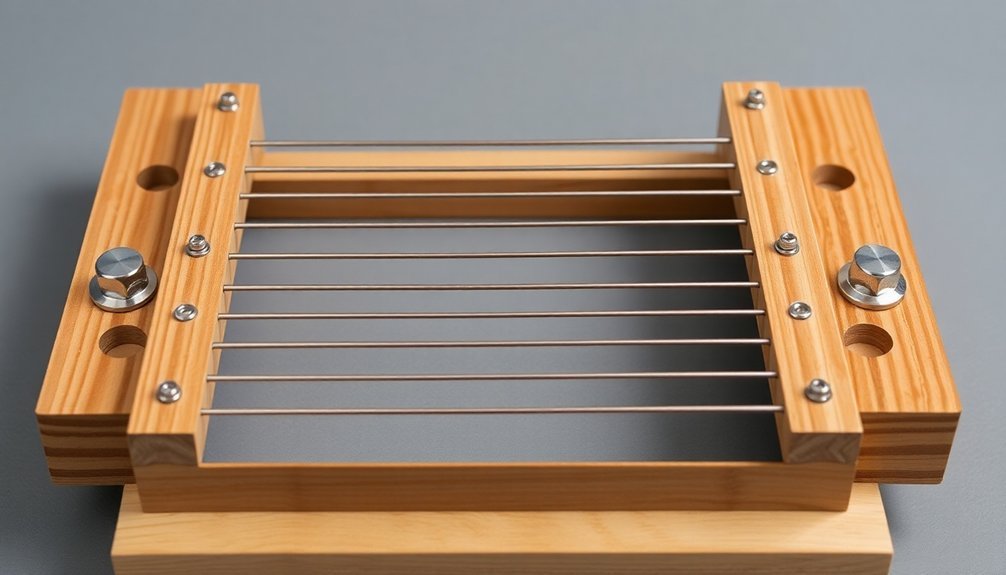
Precision meets versatility in the Multi-Wire Adjustable Soap Cutting Frame, a game-changing tool for artisanal soap makers.
You'll appreciate how this DIY project lets you achieve precise cuts while accommodating various soap block sizes for your soap-making projects.
The frame's sturdy base and guide system work together to keep the wires perfectly aligned and taut, ensuring cutting accuracy every time.
You can customize frame dimensions to match your specific needs, whether you're creating thick bath bars or thin facial soaps.
What's even better, you won't need to break the bank to build one – the frame requires just basic materials like wood and metal or nylon wires.
It's a practical investment that'll transform your soap-cutting process, giving you professional-quality bars with consistent dimensions.
Precision Measurement Guide System
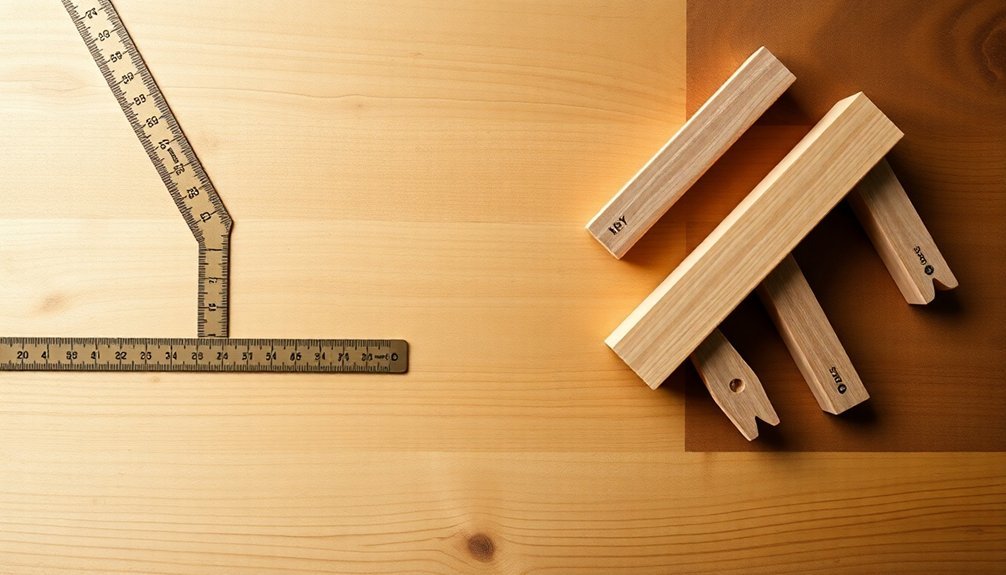
A reliable measurement guide system serves as the cornerstone of any successful woodworking project.
To achieve professional results, you'll need to equip yourself with precision measuring tools that guarantee accurate cuts every time. Digital calipers should be your go-to instrument, offering measurements up to 0.01 mm accuracy for intricate details.
Digital precision tools are essential for professional woodworking, with modern calipers providing the exact measurements needed for flawless craftsmanship.
When working on larger woodworking projects, use a laser level to maintain consistent alignment across extensive surfaces.
Don't forget to incorporate a marking gauge – it's essential for replicating measurements and ensuring uniform spacing in your joinery work.
Remember to keep your tools calibrated and your workspace clean for peak performance.
Modular Soap Block Trimming Station
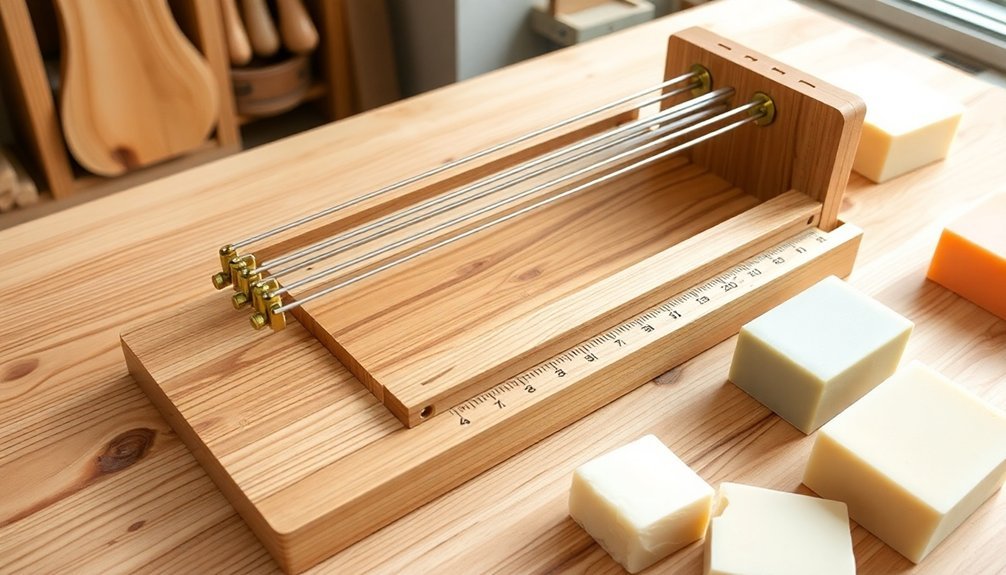
When crafting artisanal soaps, you'll need a dedicated workspace that maximizes efficiency and precision. The modular soap block trimming station offers you a versatile solution, combining both cutting tools and organizational features in one compact design.
- Efficient 33 H x 74 W x 40 L dimensions fit perfectly in your workspace
- Dual-purpose design serves as both trimming table and tool stand
- Step-by-step 3D illustrations guide you through the assembly process
- Hand tools and precision of laser measurements guarantee uniform cuts
- Affordable plans available at just $9.14
You'll find this station transforms your soap-making workflow with its thoughtful construction.
Whether you're trimming blocks or organizing your artisan tools, the modular design adapts to your needs. The detailed assembly plans make it easy to customize the station for your specific requirements, helping you achieve professional-quality results.
Simple Hand-Operated Guillotine Cutter
Making clean, uniform cuts becomes effortless with a hand-operated guillotine cutter, a versatile tool that combines mechanical advantage with precision engineering.
You'll appreciate how the sharp blade, mounted on a sturdy frame, slices through materials up to 10mm thick with minimal effort.
As a DIY enthusiast, you can build your own simple hand-operated guillotine cutter using wood and metal scraps, making it a cost-effective addition to your workshop.
When constructing your cutter, don't forget essential safety features like a blade guard and stable base to protect yourself during operation.
The lever mechanism multiplies your hand's force, ensuring precise cuts every time.
This practical tool proves invaluable for craft projects requiring consistent results, from paper cutting to woodworking applications.
Custom Mold-Sized Cutting Templates
To achieve consistent results in your woodworking projects, custom mold-sized cutting templates serve as invaluable guides for creating precise shapes and patterns. You'll find these templates essential for reducing material waste while maintaining high precision throughout your woodworking endeavors.
Key benefits of implementing custom templates:
- Create intricate designs with exceptional accuracy
- Minimize material waste through precise measurements
- Scale your templates for various project dimensions
- Enhance workflow efficiency with organized, labeled templates
- Guarantee repeatable results across multiple projects
Consider using laser cutting machines to craft your templates from durable materials like plywood or acrylic. You'll appreciate the minimal kerf width and exceptional detail these machines provide.
Frequently Asked Questions
What Is the Best Tool for Cutting Wood DIY?
You'll find different tools excel for specific cuts. For precise work, use hand saws. For bigger projects, choose circular saws or jigsaws. When you need intricate details, go with a router or laser cutter.
What Is the Best Tool for Intricate Wood Cutting?
For intricate wood cutting, you'll find a coping saw or scroll saw most effective. They'll give you precise control for detailed curves and patterns, while a laser cutter offers unmatched accuracy for complex designs.
What Tool Would Be Best to Use to Cut Curves in Woods or Manufactured Boards?
You'll find a jigsaw is your best choice for cutting curves in wood and manufactured boards. It's versatile, easy to control, and lets you adjust speeds while making smooth curved cuts in various materials.
How Do You Make Precise Cuts in Wood?
You'll achieve precise cuts by using a sharp blade, marking your lines clearly, and securing your workpiece firmly. Choose the right tool—whether it's a laser cutter, handsaw, or power saw—for your specific cut.
In Summary
Whether you're choosing the basic single-wire design or opting for a complex multi-wire system, these DIY wooden soap cutter plans will elevate your artisanal soap making. You'll save money while gaining precise control over your cuts. Don't be afraid to modify these designs to fit your specific needs – that's the beauty of building your own tools. Start with the simpler projects and work your way up.





Leave a Reply